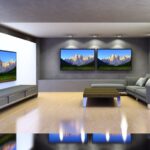To mount your TV like a pro, start by gathering essential tools like a stud finder, level, drill, and screwdriver. Choose the right mount—fixed, tilting, or full-motion—that’s compatible with your TV’s size and weight. Find a suitable wall spot, then use the stud finder to locate sturdy studs. Mark and measure accurately before installing the mounting bracket securely. Hang the TV and confirm it’s level, tightening all screws for stability. Manage cables neatly for a clean look, and adjust as needed. Following these steps carefully will help achieve a professional finish, and there’s more to uncover to perfect your setup.
Key Takeaways
- Gather essential tools like a stud finder and level, and prioritize safety gear for a smooth installation process.
- Measure wall space for your TV size and viewing distance, maintaining optimal ergonomic height for comfortable viewing.
- Choose the right mount type (fixed, tilting, or full-motion) based on your TV’s weight and size specifications.
- Locate wall studs accurately with a stud finder, mark mounting points, and ensure the bracket is level before securing it.
- Organize and conceal cables for a clean look, and regularly maintain the TV and surrounding area for an appealing installation.
Gather Your Tools
Before you begin mounting your TV, you’ll need to gather the right tools to guarantee a smooth installation process. Start by identifying the essential tool types you’ll require: a stud finder, level, drill, screwdriver, tape measure, and a socket set. These will make sure you secure your mount properly and achieve a straight installation.
Next, focus on tool organization. Having your tools within easy reach can greatly streamline the process. Use a toolbox or a portable organizer to keep everything sorted. Place your stud finder and tape measure on top for quick access, and make certain your drill and screwdrivers are easily identifiable.
Don’t forget safety gear like goggles and gloves—these are vital for protecting yourself during the installation. Once you’ve gathered and organized your tools, you’ll be ready to tackle the installation confidently.
Choose the Right Mount
When it comes to mounting your TV, selecting the right mount is essential for both safety and functionality. You’ve got several different mount types to choose from, including fixed, tilting, and full-motion mounts. Fixed mounts are great for a clean look, but they don’t allow any adjustments. Tilting mounts can help reduce glare, while full-motion mounts let you swivel and angle your TV for the best viewing experience.
Before you make a purchase, you need to take into account compatibility considerations. Check your TV’s VESA pattern (the distance between the mounting holes on the back of your TV) to confirm the mount fits. Also, take note of your TV’s weight and size, as mounts come with specific weight limits and size recommendations.
Don’t forget to factor in the wall material; some mounts require additional support for drywall or masonry. Finally, look for a mount that comes with a warranty—this can provide peace of mind. By carefully choosing the right mount, you’ll guarantee a secure installation and a superior viewing experience for years to come.
Find the Perfect Location
Having chosen the right mount for your TV, the next step is to find the perfect location for installation. Start by evaluating your ideal room layout. Consider where you’ll be sitting and the viewing angle; aim for your TV to be at eye level when seated. This not only enhances your viewing experience but also aligns with ergonomic best practices.
Next, think about aesthetic considerations. You want your TV to complement the room, not dominate it. Positioning your TV above a fireplace or in an alcove can create a visually appealing focal point. However, be cautious of glare from windows or lights that may hinder visibility.
Also, verify there’s enough space around the TV for ventilation and any additional devices, like soundbars or gaming consoles. Avoid cramped areas that can lead to overheating or clutter.
Finally, take into account the distance from the couch to the TV. A general rule is that for HD TVs, the viewing distance should be about 1.5 to 2.5 times the diagonal size of the screen. Keep these guidelines in mind to find a location that balances function and aesthetics.
Check Wall Studs
Before you mount your TV, it’s essential to locate the wall studs for proper support. Use a stud finder to pinpoint where the studs are behind the drywall, ensuring you secure the mount to a sturdy surface. Mark these locations clearly, as this will guide you in placing the mount correctly.
Find Stud Locations
To securely mount your TV, you need to locate the wall studs behind the drywall. Start by considering the wall material; drywall typically hides wooden or metal studs spaced either 16 or 24 inches apart. Understanding this spacing is essential for effective stud finder techniques.
If you’re using a stud finder, make certain to calibrate it according to the wall material. For instance, if you’re working with thicker materials like plaster, you might need a more advanced stud finder to penetrate deeper. Move the tool horizontally across the wall, and when it indicates a stud, mark the location lightly with a pencil.
If you don’t have a stud finder, you can tap the wall with your knuckles. Listen for a solid sound, which indicates a stud, versus a hollow sound, which suggests empty space. Once you think you’ve found a stud, measure 16 or 24 inches to locate additional studs.
Always double-check your findings before drilling, as misjudging stud locations can lead to an unstable mount and potential damage. Properly identifying these locations guarantees your TV is both secure and safely mounted.
Use a Stud Finder
Using a stud finder is an essential step in guaranteeing your TV is mounted securely. There are various stud finder types available, such as magnetic and electronic models. Magnetic stud finders detect screws or nails in the wall, while electronic ones use sensors to identify changes in density. Choose the type that best fits your needs and preferences.
To begin, make certain your wall is clear of any obstructions. Turn on your stud finder and place it against the wall. For electronic models, you’ll see a light or hear a beep when it detects a stud. Slowly move the finder horizontally across the wall, marking the stud locations once detected. Repeat this process vertically to confirm the stud’s edges.
When using a stud finder, make sure you follow the manufacturer’s instructions for ideal stud finder usage. Remember to check for multiple studs to provide a sturdy foundation for your TV mount. Once you’ve located the studs, measure and mark where you’ll be drilling your holes. This thorough approach will guarantee your TV is safely mounted and reduces the risk of damage to your wall or television.
Mark and Measure
Now that you’ve checked the wall studs, it’s time to mark and measure for your TV mount. First, choose the ideal wall location based on your room layout and viewing preferences. Then, measure the appropriate viewing height and mark your mounting points to guarantee a secure installation.
Choose Wall Location
Choosing the right wall location for your TV is essential for best viewing and aesthetics. You want to make sure that the TV not only looks good but also provides an ideal viewing experience. Here are some key factors to think about when selecting your wall location:
- Distance from Seating: Make certain the TV is at an appropriate distance from your seating area for comfortable viewing.
- Wall Aesthetics: Choose a wall that complements your room’s design. Reflect on where other furniture is placed.
- Lighting: Avoid walls with direct sunlight, which can cause glare on the screen.
- Electrical Outlets: Check for nearby outlets to minimize the need for extensive wiring and improve cable management.
- Wall Type: Confirm the wall can support the weight of your TV and mount; drywall or brick may require different anchors.
After evaluating these factors, mark your chosen location carefully. Use a pencil to outline where the mount will go, making sure that you’ve accounted for both aesthetics and functionality. This thoughtful approach will set the stage for a clean, professional-looking installation.
Measure Viewing Height
Determining your TV’s ideal viewing height is essential for a comfortable and enjoyable experience. To find this height, start by measuring your eye level while seated in your usual viewing position. A common guideline is to set the center of the TV screen at or slightly below your ideal eye level, typically around 42 inches from the floor for most people.
Next, consider the dimensions of your TV. If you have a larger screen, you might want to raise it slightly to guarantee it fits within your room’s aesthetics and doesn’t dominate the space.
Also, take into account room lighting. Positioning your TV too high can cause glare from windows or overhead lights, making it harder to see. Ideally, you want to minimize reflections while maintaining that perfect viewing angle.
Once you’ve measured your eye level and accounted for lighting, mark the spot on the wall where you plan to mount your TV. This preliminary measurement will help you visualize the setup and guarantee a comfortable viewing experience, so take your time to get it right before moving forward.
Mark Mounting Points
Once you’ve established the ideal height for your TV, it’s vital to mark the mounting points accurately to guarantee a secure installation. This step is significant, as improper markings can lead to a wobbly TV or damage to your wall. Follow these practical tips to get it right:
- Use a Level: Verify your markings are straight by using a level tool. This helps maintain an even installation.
- Identify Wall Studs: Use a stud finder to locate wall studs, as they provide the best support for your mounting techniques.
- Check Wall Material: Different wall materials (drywall, concrete, etc.) require specific anchors and screws. Make sure you’ve got the right hardware.
- Mark with a Pencil: Lightly mark the mounting points with a pencil for easy adjustments. Avoid using permanent markers.
- Double-Check Measurements: Measure twice before drilling. Confirm that your marks align with the TV mount’s bracket holes.
Install the Mounting Bracket
Installing the mounting bracket is an important step in securely attaching your TV to the wall. Begin by selecting the right bracket for your TV’s size and weight, as this will determine the mounting techniques you’ll use. Most brackets come with a weight limit, so make certain it aligns with your TV specifications.
Once you’ve chosen the appropriate bracket, align it with the marked points on the wall. Use a level to verify it’s straight. If you’re mounting on drywall, locate the studs for additional support. Use a stud finder to pinpoint these, and if needed, adjust your bracket placement accordingly.
Next, attach the mounting bracket to the wall using the provided screws. Make sure to drive them into the studs, as this is vital for stability. If you’re using toggle bolts for drywall installation, follow the instructions carefully to guarantee a secure fit.
After securing the bracket, double-check its stability by gently pulling on it. If it feels solid, you’re ready for the next step. You’ve now laid the groundwork for a safe and professional TV installation!
Connect Cables and Wires
With the mounting bracket securely in place, it’s time to connect the necessary cables and wires for your TV setup. Proper cable management is essential for a clean look and to avoid any potential tangling or damage. Here’s a step-by-step guide to help you connect everything efficiently while ensuring ideal wire concealment.
- HDMI Cables: Connect your HDMI cables from the TV to your devices, like a streaming box or gaming console.
- Power Cable: Plug the TV’s power cable into the wall outlet or a power strip, ensuring it’s easily accessible.
- Audio Cables: If you’re using an external sound system, connect the audio cables accordingly.
- Ethernet Cable: For a stable internet connection, connect an Ethernet cable if your TV supports it.
- Cable Ties: Use cable ties to bundle and secure any excess cables to keep them organized.
To achieve seamless wire concealment, consider using cable covers or wall conduits. This not only enhances the aesthetic of your setup but also protects the wires from wear and tear. By following these steps, you’ll set up a tidy and professional-looking TV installation.
Hang the TV
Now that you’ve prepared your cables and wires, it’s time to get your TV up on the wall. First, verify you’ve identified the best TV positioning techniques. Ideally, the center of your screen should be at eye level when you’re seated, so measure that height from the floor.
Next, consider the wall material. If you’re mounting on drywall, locate the studs using a stud finder, as this will provide the necessary support. If the wall is concrete or brick, you’ll need masonry anchors to secure your mount. Mark the desired height and location clearly, verifying it aligns with your viewing area.
Once you’ve marked the spots, drill pilot holes into the studs or wall anchors. Attach the mounting bracket to the wall using the provided screws, verifying everything is tight and secure. If your TV has a separate mounting plate, attach it per the manufacturer’s instructions.
Finally, carefully lift the TV onto the mounted bracket. It’s best to have someone assist you with this step to avoid any mishaps. Make sure the TV is securely fastened before you proceed to the next steps in the mounting process.
Level the TV
Achieving balance is essential when it comes to mounting your TV, as a level screen guarantees a superior viewing experience. Proper TV leveling techniques are vital to avoid neck strain and make sure you enjoy your favorite shows without distraction. Here’s how to get it just right:
- Use a Level Tool: Invest in a bubble level or a laser level for accurate measurements.
- Adjust the Mount: If your mount has adjustable features, tweak it until the TV is aligned.
- Check Multiple Points: Measure at both the top and bottom of the TV to make sure even leveling.
- Use a Smartphone App: Many smartphones have built-in level apps that can assist in achieving accuracy.
- Reconfirm Before Securing: Once you think it’s level, double-check before you finalize the mounting.
Secure and Test
After confirming your TV is perfectly leveled, the next step is to secure it properly and conduct a thorough test. Begin by tightening all the screws and bolts on the mounting bracket. Make sure to follow the manufacturer’s instructions to guarantee secure mounting. If your mount includes safety straps, fasten those as well to add an extra layer of security.
Once everything is tightened, it’s important to test stability. Gently push the TV from various angles to check for any wobble or looseness. If you notice any movement, recheck the screws and bolts to verify they’re properly tightened. It’s crucial to make sure that the mounting system can hold the TV securely, especially if you have kids or pets around.
Next, plug the TV in and check that all connections are secure. Turn the TV on and adjust it to your preferred viewing angle. After confirming that everything is functioning well, step back and visually inspect the installation to ensure it looks straight and professional. This final check will give you confidence that your TV is securely mounted and ready for use.
Final Adjustments and Tips
Once everything is securely mounted, it’s time to make those final adjustments for ideal viewing. This is where you can add the final touches to guarantee your TV looks great and enhances your space. Here are some practical tips to take into account:
- Adjust the tilt: Use the mount’s tilt feature to minimize glare from windows or lights.
- Level the screen: Double-check that your TV is perfectly level; even a slight angle can be distracting.
- Hide the cables: Use cable management solutions to conceal wires, contributing to a clean aesthetic.
- Position for comfort: Sit on your couch and confirm that the screen height is comfortable for viewing—ideally, the center of the screen should be at eye level.
- Evaluate lighting: Make sure your room lighting complements the TV setup; avoid harsh lighting directly facing the screen.
With these adjustments, you’re not only optimizing your viewing experience but also enhancing your room’s aesthetic considerations. Take your time with these final touches to guarantee your TV is both functional and visually pleasing.
Frequently Asked Questions
How Do I Ensure My TV Is Safe From Falling?
To guarantee your TV’s safety from falling, use proper mounting techniques like wall brackets and anchors. Additionally, consider safety measures such as securing cables and avoiding excessive weight on the mount to prevent accidents.
Can I Mount a TV on Drywall Without Studs?
Imagine your TV floating gracefully on the wall. You can mount it on drywall without studs using heavy-duty drywall anchors and proper mounting brackets. Just guarantee the anchors are rated for your TV’s weight for safety.
What if My TV Is Too Heavy for the Mount?
If your TV’s too heavy for the mount, consider using heavy mounts specifically designed for larger screens. Alternatively, explore mounting alternatives like reinforced wall brackets or freestanding TV stands to guarantee stability and safety.
How Do I Hide Cables After Mounting the TV?
To hide cables after mounting your TV, use cable management solutions like raceways or wall concealment kits. Run cables neatly along walls, ensuring they’re secured and out of sight, maintaining a clean, professional appearance.
Can I Mount a TV in a Corner?
Yes, you can corner mount a TV. Make certain the mount’s designed for corner use, allowing ideal viewing angle. Pay attention to wall studs for secure installation, and consider cable management for a clean look.
Conclusion
Now that you’ve successfully mounted your TV, you’re not just enhancing your viewing experience; you’re also maximizing your living space. Did you know that wall-mounted TVs can save up to 4 square feet of floor space? This makes your room feel more open and inviting. Remember to periodically check the mount’s stability and clean behind the TV for dust buildup. With your TV securely in place, you can enjoy a sleek, professional look in your home entertainment area.






